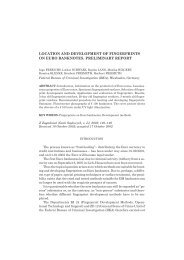Download PDF - PROBLEMS OF FORENSIC SCIENCES
Download PDF - PROBLEMS OF FORENSIC SCIENCES
Download PDF - PROBLEMS OF FORENSIC SCIENCES
You also want an ePaper? Increase the reach of your titles
YUMPU automatically turns print PDFs into web optimized ePapers that Google loves.
Revolver Harry and Kalle Blomqvist... 119<br />
While in Lyon Harry also took the opportunity to take a doctor’s degree at<br />
the University of Lyon. His research work naturally concerned criminal investigation.<br />
It was about analysis and identification of pistol bullets. He was<br />
the first to make a scientific study of the individual markings on fired bullets<br />
that originate from the grooves in the barrel and the cartridge case due to<br />
the firing pin.<br />
In order to examine pistol bullets quickly, he invented an apparatus he<br />
called a Hastoscope. It was a comparison microscope where the bullets investigated<br />
could be turned and rotated, either together or individually.<br />
After six years with Mr. Locard in Lyon he thought himself skilled<br />
enough and returned to Sweden. Once back home he started a small private<br />
bureau in Stockholm where he offered forensic services, and above all, certificates<br />
of authenticity of documents. His work progressed more and more successfully,<br />
and soon he was appointed docent in criminology at the University<br />
of Stockholm.<br />
He got a grant and went to the USA to make contacts and study the forensic<br />
progress of the new world.<br />
In 1939 Doctor Harry Söderman became head of the recently formed<br />
SKA – The Swedish National Board of Forensic Science – in Stockholm. The<br />
purpose of the institution was to give the police means and competence to<br />
make accurate analyses and investigations on the scene of a crime, and that<br />
was a predecessor to today’s SKL – The National Laboratory of Forensic Science<br />
in Linköping.<br />
Because the criminal always leaves marks, Harry told his new colleagues<br />
and pupils. It is only a question of having methods sophisticated enough to<br />
detect them.<br />
Harry Söderman was now considered one of the leading forensic technicians<br />
in the world, and lectured both in the USA and at Scotland Yard in<br />
London. In New York he took part in the development of a new forensic laboratory.<br />
Thanks to his excellent knowledge of languages – he spoke fluent<br />
German, French and English – he naturally became a prominent figure in<br />
the international police collaboration, and he was one of the founders of<br />
Interpol.<br />
During his journeys all over Europe and the USA he collected the latest<br />
findings concerning criminal investigation. He summarised it all in “The<br />
Handbook of criminal investigation”, a thick book of 680 pages, which accounted<br />
for forensic methods from antiquity to our own time. Here he discussed<br />
matters, such as identification of individuals by fingerprints, the collection<br />
of traces on the scene of the crime and photographic documentation,<br />
witness psychology, analyses of powder stains, pistol bullets and bullet-holes,<br />
analysis of writing and other such things.
















